
Robots on the move: Professional service robots set for double-digit growth TMT Predictions 2020
15 minute read
09 December 2019
The market for professional service robots is poised to take off with a vengeance, fueled by new developments in 5G telecom services and AI chips.
The idea of robots picking items from warehouse shelves may still seem futuristic today. But the future may be closer than many people think. Of the almost 1 million robots we expect to be sold for enterprise use in 2020, we predict that just over half of them will be professional service robots, generating more than US$16 billion in revenue—30 percent more than in 2019. What’s more, with regard to enterprise spending, the market for professional service robots is growing much faster than that for industrial robots (figure 1). If recent trends are any sign, professional service robots may pass industrial robots in terms of units in 2020 and revenue—in 2021.
That’s not to say that the industrial robotics market is hurting. We expect revenues from industrial robot sales in 2020 to reach nearly US$18 billion, a 9 percent increase over 2019. But although industrial robots will remain important in the years to come, the professional service robot market is poised to take off with a vengeance, fueled by new developments in 5G telecom services and artificial intelligence (AI) chips.
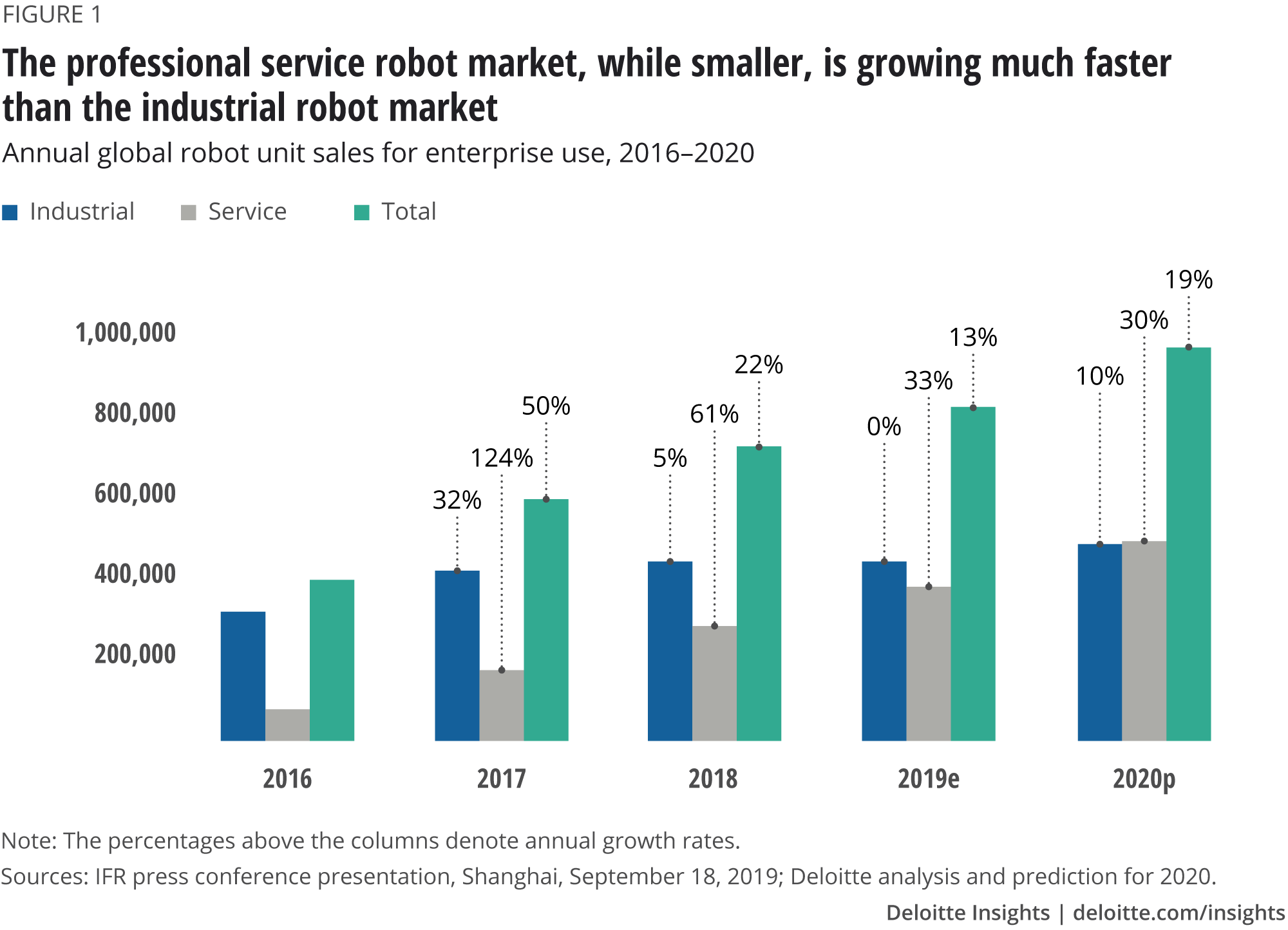
What are industrial and professional service robots, and how do they differ?
The enterprise robotics industry actually serves two distinct markets: industrial and professional services. While it’s common to lump both types together under the single word “robot,” industrial robots and professional service robots do different things, cost different amounts, and have had—and likely will have—very different growth trajectories.
Industrial robots have been around since the 1970s. The archetypal industrial robot is the mechanical arm, with varying levels of freedom and flexibility, found in factories around the world. The biggest users (in descending order) of industrial robots are the automotive, electrical/electronics, metal, plastics and chemicals, and food and beverage verticals within the manufacturing industry.
Professional service robots are more recent, with the market only really taking off within the last decade. In contrast to industrial robots, professional service robots are mainly used outside of manufacturing, and they usually assist humans rather than replace them. Most are designed with wheels to make them mobile or semimobile; some professional service robots have arms, but they are a minority, and the arms are not capable of (or intended for) the kinds of heavy tasks that most industrial robots tackle. Thus far, professional service robots have been most popular in the retail, hospitality, health care, and logistics (in warehouse or fulfillment settings) industries, although some are also used in space and defense, agriculture, and demolition.1
As time goes on, the distinction between various types of robots—industrial and service, enterprise and consumer—is becoming less clear. Is an automated dolly that carries partially built automobiles from place to place in a smart factory a professional service robot or an industrial robot? Even the definition of what we consider to be a robot is in flux, as companies start to put more advanced capabilities into new form factors, such as speakers.
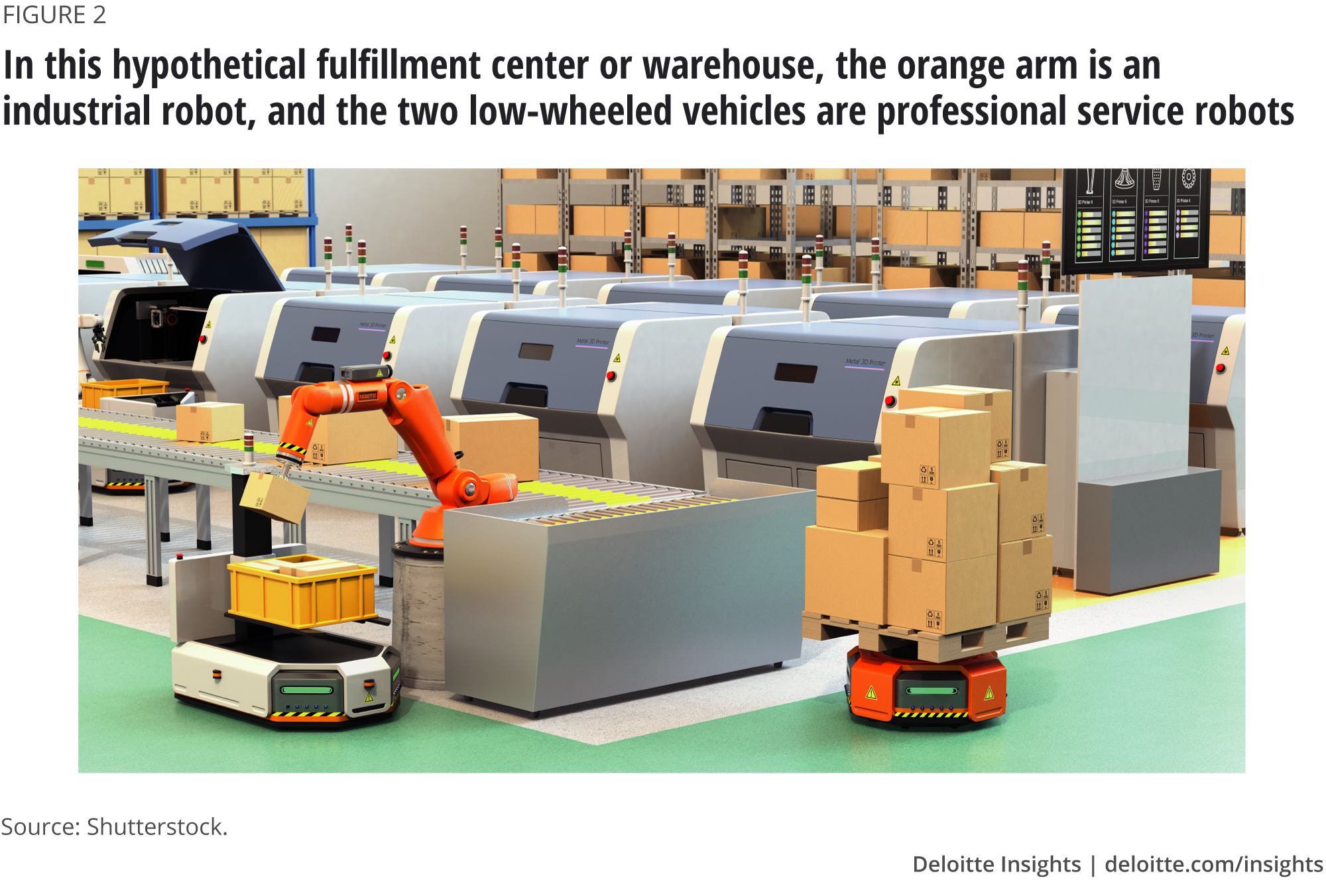
Industrial robots: A welcome return to growth
Learn more
View TMT Predictions 2020, download the report, or create a custom PDF
Download the infographics
Watch the video on this year’s TMT Predictions
Download the Deloitte Insights and Dow Jones app
Subscribe to receive related content
The 10 percent growth in unit sales we predict for industrial robots in 2020 is much better than the sector fared in 2018 and 2019. In 2018, unit sales went up 5 percent, and actually declined slightly in 2019. The forecast return to higher growth in 2020 is very good news for the industrial robot industry after two years (and counting) of disruption by trade wars, tariffs, and the associated slowdown in the automotive and technology sectors, and in China.
Industrial robots find their greatest use in the automotive industry, where robots on assembly lines build cars, and the electrical/electronics industry, which uses robots to put chips on circuit boards. In 2018, these two industries combined drove 60 percent of all global demand for industrial robots, accounting for about 120,000 (for automotive) and 110,000 (for electrical/electronics) unit sales. In terms of growth, automotive demand was up by 2 percent, and electrical/electronics demand fell by 14 percent, in 2018 from 2017.2
With respect to geography, China is the largest market for industrial robots: 154,000 industrial robots were sold in China in 2018, accounting for 36 percent of global industrial robot demand. This is nearly three times as many as were sold in Japan, the second-largest market, and nearly four times as many as in the United States and South Korea, the third- and fourth-largest markets.3
While the industrial robot market looks poised to resume healthy growth, it is still growing much more slowly than many expect. This may, however, be due to inflated expectations rather than any shortcomings in the industrial robot market. Alarmist projections—such as a 2015 forecast from the Bank of England that the United Kingdom would lose 15 million jobs to robots,4 or a 2018 Brookings study stating that one-quarter of all US jobs were at high risk of automation,5 or the World Bank’s 2017 estimate that robots would take over 600 million jobs globally by 20326—are widely reported, and can conjure up scenarios of robots running rampant in the near future. In reality, reports of these estimates usually select their numbers from the higher (more alarming) end, and the projections themselves encompass not only actual physical robots (both industrial and professional service) but also tools such as AI and robotic process automation. Most people, if told how fast the industrial robot industry is growing, might find the 10 percent figure for 2020 to be much lower than their expectations … or fears.
Modest growth in sales, of course, doesn’t translate into modest numbers of robots. The global installed base of industrial robots is large and still growing. Even during 2018 and 2019 sales slowdown, anywhere between 2.5 and 3 million industrial robots were already hard at work around the world. By 2021, this global installed base is likely to be 93 percent larger than in 2016 (figure 3). And once installed, industrial robots last a long time: A decade of useful life (80,000–100,000 hours of work) is not unusual, though this varies by application.7
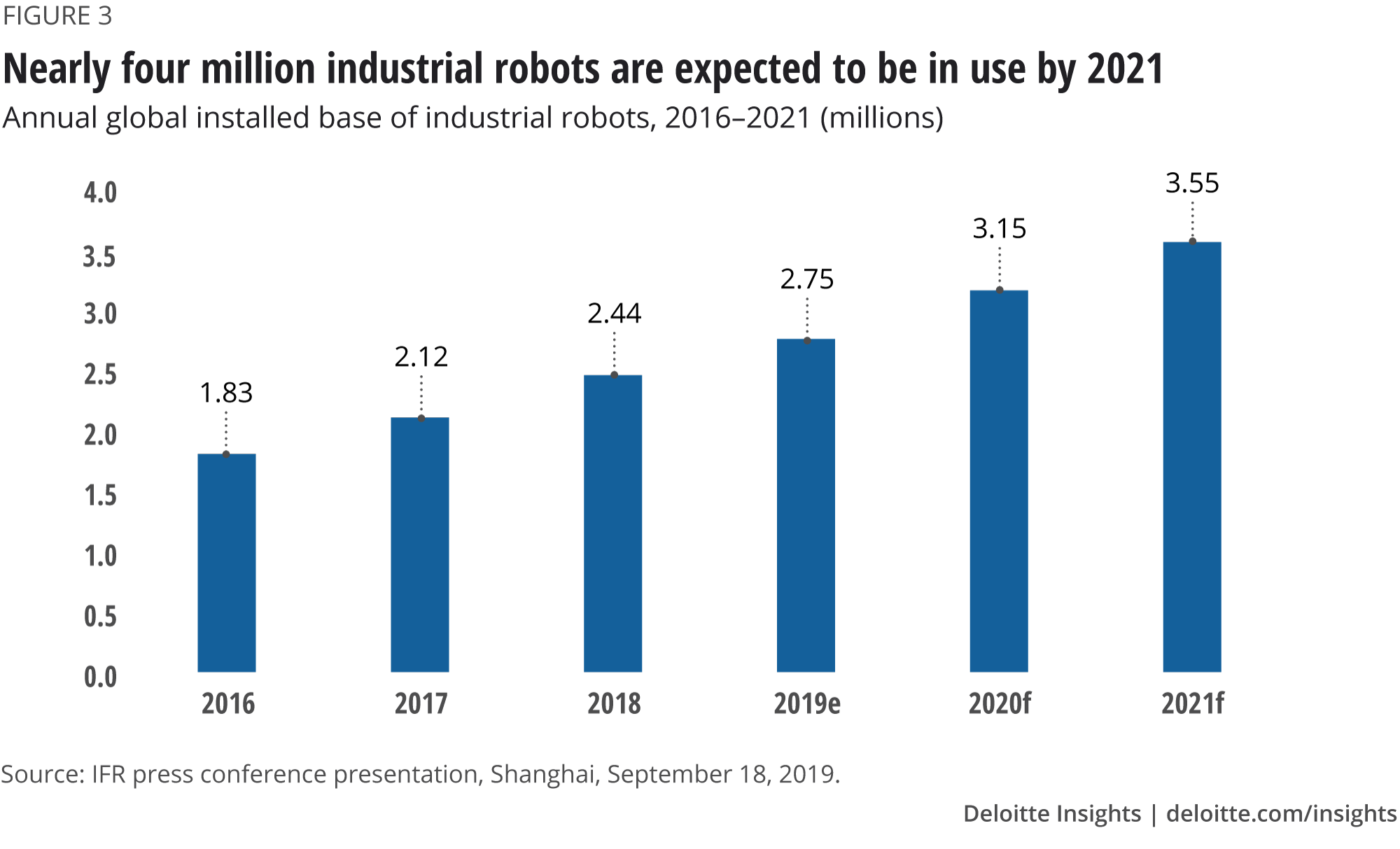
While the installed base is the more important metric for those who use robots, annual sales and annual sales growth are of critical interest to companies that make robots. In 2017, the International Federation of Robotics report predicted that in 2020, for the first time in history, global industrial robot sales would reach more half a million units (550,000, to be exact)—more than double the 254,000 units sold in 2015.8 As a result of the 2018 and 2019 slowdown, that prediction will likely be wrong: Sales of industrial robots will now only break the half-million mark in 2021, with an expected volume of 522,000 units.
Professional service robots: Robotics’ growth hot spot
Some might say that professional service robotics’ rapid recent growth is an artifact of the industry’s youth and small size. Only about 100,000 professional service robots worldwide were probably in use as of 2015,9 and global professional service robot sales in 2016 were a mere 100,000 units. On such a small base, achieving double-digit growth from 2017 to 2019 was comparatively easy.
However, that’s not why we predict that the professional service robot industry will grow almost as quickly in 2020 and even beyond. Instead, we base this prediction on the impact of two technological advancements: the improvements in wireless connectivity made possible by 5G network technology, and the falling price and rising power of edge AI chips that can perform processor-intensive AI tasks on the actual robot, rather than through the cloud. The use of 5G and edge AI chips together can solve many challenges that limit professional service robots’ practicality today, making them more useful—and more attractive—to enterprise buyers.
Connectivity is one such challenge. Maintaining reliable connectivity for professional service robots, which usually need to be mobile, is often difficult. Connecting via wire is one solution, but this constrains mobility. Wi-Fi is an inexpensive wireless option, but quality of service is not guaranteed, and handover between access points is often not reliable. 4G wireless networks can be expensive (often charging a monthly connection fee) and latency can be high, limiting a robot’s ability to react quickly. Density can also be problematic with 4G. Although one can hardwire a factory with literally thousands of industrial robots, 4G could have trouble handling that many professional service robots in the same footprint.
The use of 5G could address all of these issues. The full 5G standard provides for a 99.9999 percent (six nines) reliability rate, which means an expected downtime of just five minutes per year.10 A technology known as network slicing, which allocates network performance to different tasks based on their priority, can further enhance reliability for top-priority tasks. 5G also delivers submillisecond latencies, allowing for much faster reaction times than LTE’s 40–50 milliseconds or Wi-Fi’s 100-plus milliseconds. 5G supports connection densities of up to 1 million per square kilometer; in a largish factory or warehouse of 10,000 square meters, a 5G network could connect 10,000 devices, while the 4G LPWA specification would max out at 607.11 5G service providers would still charge a monthly fee, but a company may be able to control these costs by building a private 5G network.12 And although 5G today still has trouble in environments containing a great deal of metal, its recent 3GPP Release 16, to be finalized in December 2019, is designed to address many of these shortcomings. No other mobile connectivity technology, including 4G and Wi-Fi, can function well in a metal-filled industrial environment.
For their part, advances in edge AI chips can benefit professional service robots in terms of both performance and power consumption. Because mobile professional service robots run on batteries, power often limits what they can accomplish. Running on-the-go machine learning algorithms using traditional chips such as graphics processing units (GPUs), which consume hundreds or even thousands of watts, is impractical for a battery-powered robot. Chips designed specifically for AI computations, however, draw much less power, and fewer of them are needed for a given amount of processing, making it easier to fit the required number of chips into a professional service robot’s design. In cases when the robot’s own chips aren’t enough, 5G can connect the robot to more powerful processors elsewhere on the site, on a telecom edge server, or in the cloud.
Why shouldn’t 5G and edge AI chips boost industrial robot growth to the same degree? To some extent, we believe they will. Both types of robot will use these new technologies, and both types will improve their capabilities as a result. But the improvement opportunity is far greater for professional service robots than for industrial robots. Industrial robots today are usually connected to a wired factory network; they thus already have high-speed (if needed), ultra-reliable, low-latency connectivity, with minimal annual operating costs. They also have lots of space for extra chips to support machine learning, and their wired connection makes it easy for them to cheaply and reliably access more powerful remote processors if need be. And unlike most professional service robots, industrial robots don’t run on batteries: They are plugged into the power grid, at any combination of volts, watts, and amps desired.
The edge AI chip industry appears ready for the challenge. Major manufacturers such as Intel,13 Nvidia,14 and Google15 (with more to follow) are already selling edge machine learning chips that cost less than US$100 and use less than 10 watts; most of these are smaller than a postage stamp, with the largest about the size of a credit card. These chips are less powerful than the machine learning accelerators containing hundreds of chips that may be found in data centers at the network core, but they are quite capable of the kinds of on-board AI computations that enable professional service robots to perform their tasks, even when connectivity is not available. We expect 50 million enterprise edge machine learning chips to be sold in 2020 alone, growing to 250 million chips by 2024.16

As for 5G, robotics is expected to make up a sizable fraction of the enterprise IoT market, which in turn is predicted to be one of 5G’s major beneficiaries. (“Cloud robots: The killer 5G application,” screamed one recent headline.)17 Across all applications (not just robotics), 5G IoT connections are expected to number a staggering 4.1 billion by 2024, up from 1 billion in 2018—a 27 percent compound annual growth rate.18 In terms of dollars, revenues for the total 5G IoT market (again, not just for robotics) are forecast to grow by an average of 55 percent per year for the next five years, from only US$694 million in 2020 to US$6.3 billion in 2025.19 The market for private 5G networks—many of which will almost certainly be used to connect robots—will also likely increase. Worth only a few hundred million dollars in 2020, private 5G installation spending by enterprises is expected to total billions of dollars in 2023;20 in Germany, a number of private 5G networks were already in use for professional service robots on production lines in 2019.21
Which end markets are using professional service robots most heavily? Just as the industrial robot sector is dominated by automotive and electronics, the professional service robot sector is dominated by logistics (figure 4). Just under half of the roughly 360,000 professional service robots sold to enterprises in 2019 went to logistics companies. Second and third place go to inspection and defense, which accounted for another 33 percent and 4 percent, respectively, of 2019’s professional service robot unit sales. Worth special mention is that, while medical robots made up less than 2 percent of the professional services robots sold in 2019, their high price—about half a million US dollars each in 2019—puts their collective price tag at US$3.7 billion, just under 30 percent of the professional service robot industry’s total revenues for that year.22
Consumer robots: Low in revenue, but high in numbers
In addition to the industrial and professional service robots used by enterprises, there are two large and growing consumer robot markets. Consumer service robots, designed for tasks such as vacuuming, mowing the lawn, and washing windows, sold 17.6 million units in 2019, up 44 percent from 2018. And entertainment robots—mainly toys made in Asia, some of which are fairly sophisticated—sold 4.5 million units in 2019, 10 percent more than in 2018.23
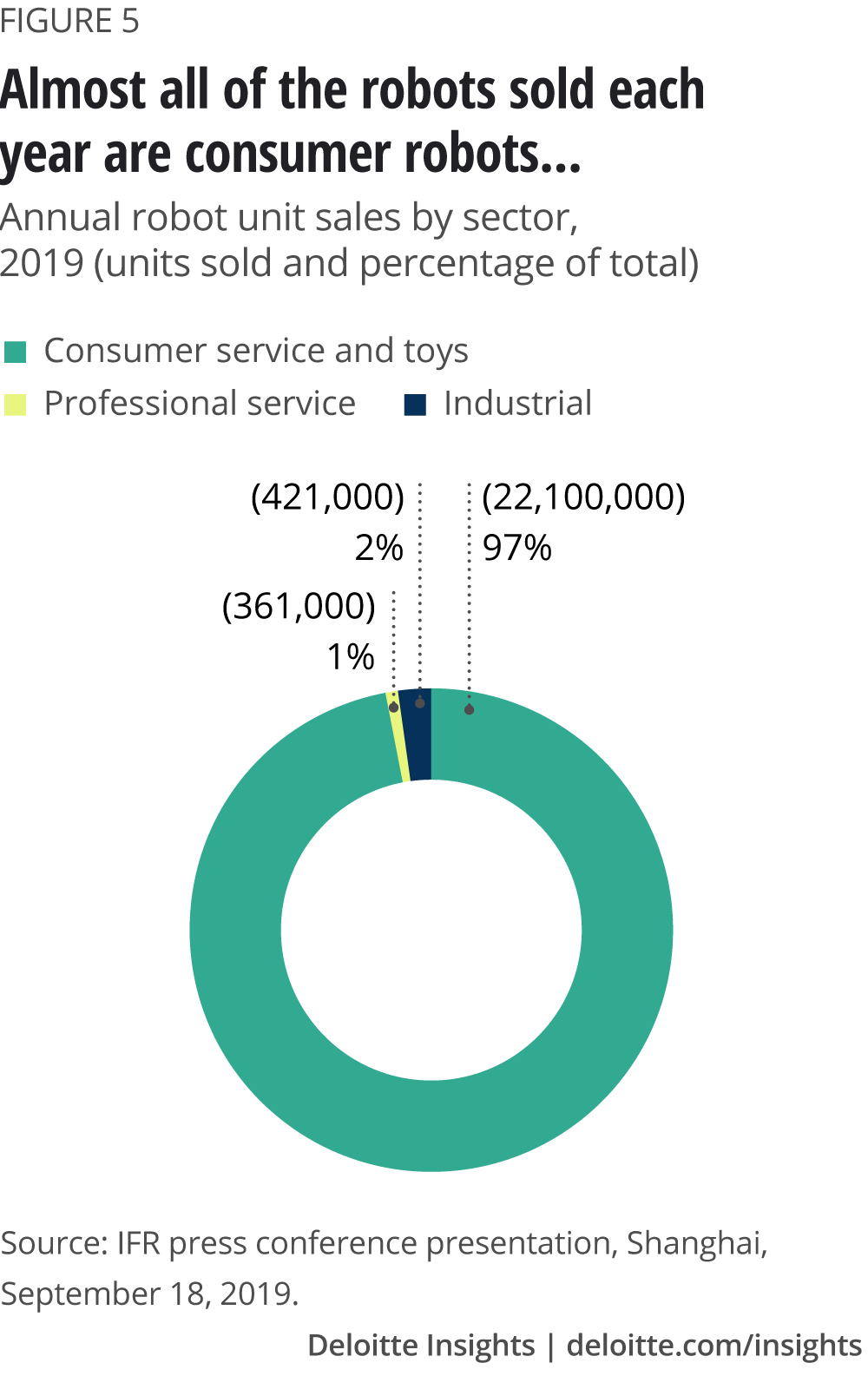
When it comes to counting annual unit sales of robots, the consumer business matters a lot (figure 5). But when it comes to dollars, it is much less important (figure 6). Although 97 percent of all of the robots sold each year are consumer robots, they are responsible for just one out of every seven dollars of robotics industry revenue. That said, the growth drivers of 5G and AI chips are also likely to have a strong influence on consumer robots. A smarter robotic vacuum cleaner that uses AI to distinguish between cleanable dirt and a puppy’s accident would be a game-changer.24
The bottom line
Although the robotics industry will likely return to 20 percent-plus growth in 2020, companies should not anticipate hypergrowth. 2017 saw a remarkable 32 percent growth rate for industrial robots, but overall, the industrial robot market grew at a CAGR of 13 percent between 2008 and 2019, and that is roughly what we predict going forward for service and industrial robots combined. This is not enough growth to drive massive job losses to robots in the near term, nor enough to enable every company in the world to rapidly roboticize.
The market for industrial robots, we expect, will continue to expand … a bit, but not exponentially, as these machines become more powerful and flexible due to advances in machine learning. Most companies that need or anticipate needing industrial robots already have them, or at least have them on their road map. There are only so many use cases where a robot arm is the right tool for the job and delivers a high enough return on investment.
What can be more challenging is for companies to assess if and when professional service robots are the right tool for the job. Their price, power, and flexibility—driven by advances in 5G and in edge AI chips—will be very different in 2025 than in 2020. Increasingly, robots are no longer just about making goods better, cheaper, or faster. A new generation of more capable and flexible robots will increasingly impact decisions about where to manufacture goods, which goods to manufacture, and how to cope with the challenges of scarce or high-cost labor.25 Correctly anticipating use cases and ROI will likely be an important task for strategists going forward—both for those who make and sell robots, and for those who use them.
What exactly is a robot? Shifting categories and blurring lines
The United States is suffering from a nursing shortage that is likely to get even worse in the near future, as more than a million Registered Nurses retire by 2030 and the population ages.26 Several Texas hospitals are turning to robots to fill the gap. But instead of automating nursing tasks such as taking vitals or changing bedpans, the robots instead augment existing nursing staff by performing non–patient-facing work.
Meet Moxi (figure 7), a mobile service robot with a light-duty industrial arm manufactured by a Texas company called Diligent.27 Connected to the hospital network and patients’ electronic health records, Moxi executes simple tasks such as dropping off specimens or placing an admission bucket—fresh supplies for a new patient—in cleaned rooms ready to receive patients.
These are not particularly difficult tasks, but for overworked nurses who have patients to care for, not having to do them can make all the difference. As reported in a 2019 Fast Company article: “One nurse in Dallas … told the team that she never saw Moxi put admission buckets in clean rooms, but that the buckets were just always where they were supposed to be. The nurse told the Diligent team that she just didn’t have to think about the task anymore—which means that she could spend more time with patients.”28
But Moxi doesn’t just slink from room to room executing menial tasks. It also has, perhaps surprisingly, a social element, with nurses greeting it, patients taking selfies with it, and children writing to the robot’s creators asking where it lived.29 The robot wanders around the hospitals once per hour, flashing hearts (where its eyes are) at passersby.
Robots like Moxi are testing the limits of what we conceive of robots to be. In Douglas Adams’ 1979 cult classic The Hitchhiker’s Guide to the Galaxy, the Sirius Cybernetics Corporation defined a robot as, “Your plastic pal who’s fun to be with!”30 Now, the joke is increasingly on us, as robots become, not just arms or wheels, but speakers, voices, conversations, and social relationships.
If Moxi is practically three robots in one (service, industrial, and consumer), still more confounding is the prototype of Alice (figure 8), a robot originally designed to alleviate loneliness in the elderly and now being explored to help those with dementia as well.31 Without arms and without wheels, but more than just a smart speaker, Alice can have a conversation, move her head, and show simple facial expressions. One can imagine Alice 2.0 having wheels, or even arms, for simple tasks such as fetching things or helping with feeding. But even in her current configuration, she is forcing us to broaden our definitions of what a robot is.
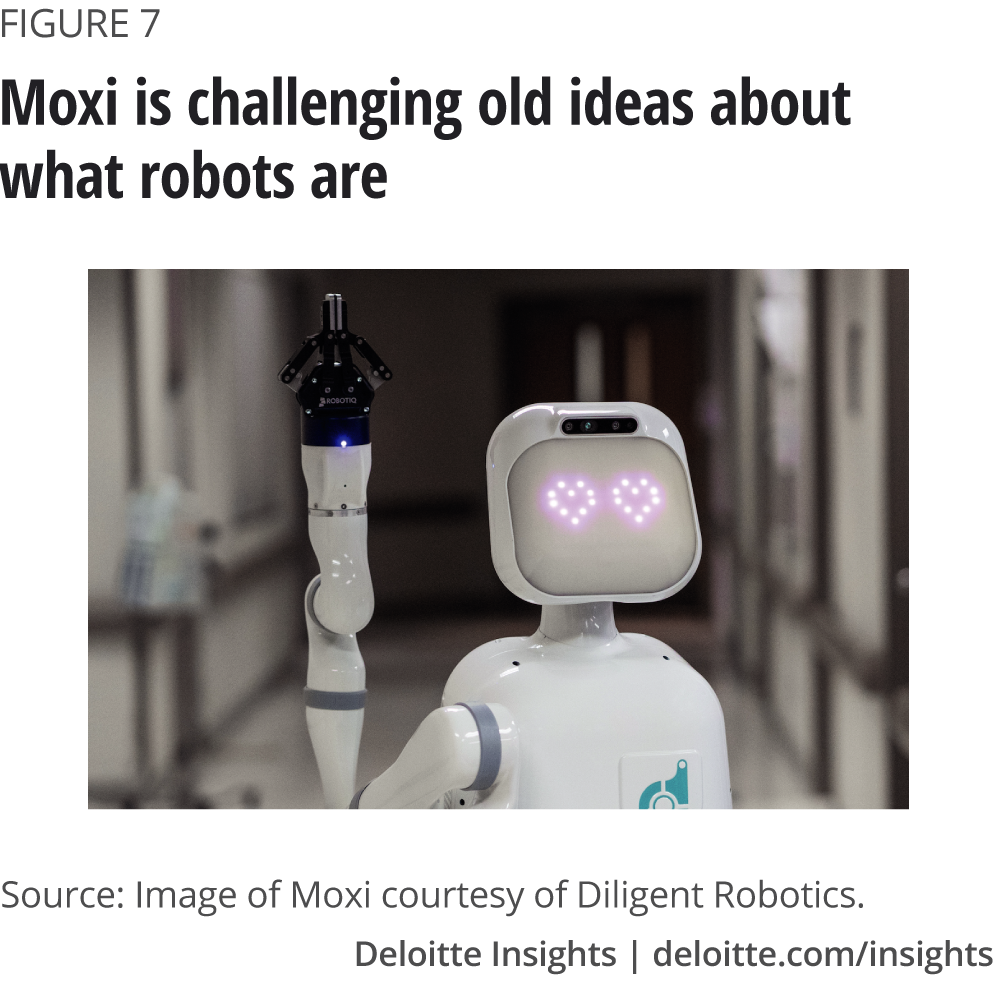
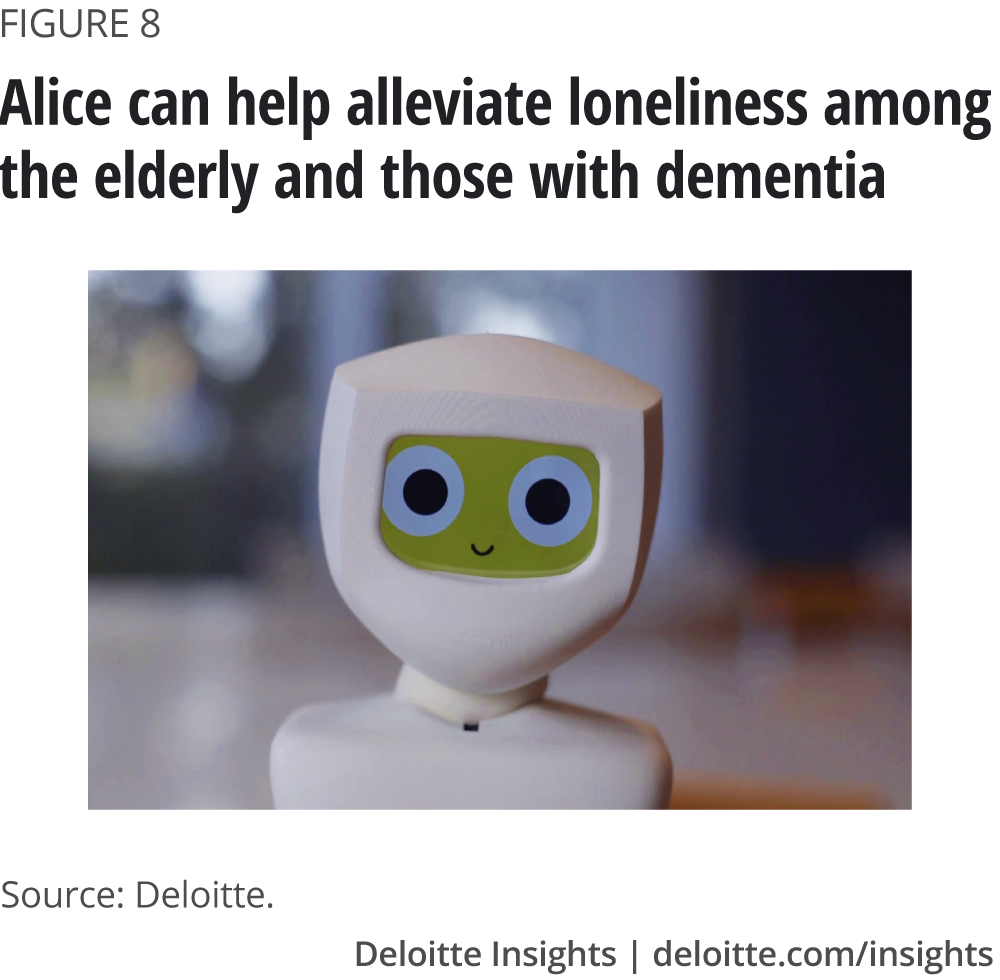
The need for something like Alice is pressing. The market for robots for the handicapped and elderly is estimated at only 30,000 units between 2019 and 2021, but it is expected to expand significantly over the next two decades.32 By 2050, the world will have 2.1 billion people age 65 and up, three times as many as today, with nearly half a billion those more than 80 years old.33 And loneliness is a problem among dementia sufferers too, who are almost twice as likely to experience high levels of loneliness than the general public.34
It’s convenient today to categorize robots by their primary use: industrial, service, entertainment. But robots like Moxi and Alice show that such categories are by no means carved in stone. Perhaps the broader lesson is that it’s not what one calls a machine that’s important—it’s what the machine can do.
© 2021. See Terms of Use for more information.
Explore the collection
-
My antennae are tingling: Terrestrial TV’s surprising staying power Article5 years ago
-
The ears have it: The rise of audiobooks and podcasting Article5 years ago
-
Ad-supported video: Will the United States follow Asia’s lead? Article5 years ago
-
Coming to a CDN near you: Videos, games, and much, much more Article5 years ago
















